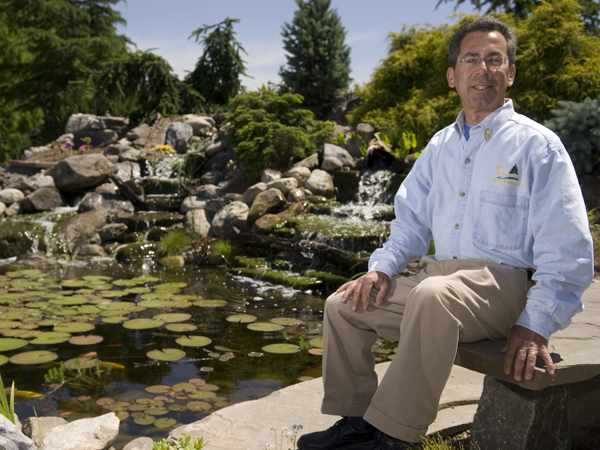 Landscapers save rainwater for watering gardens
Landscapers save rainwater for watering gardens
by Brian James Kirk
Throughout the Wissahickon watershed, a 64 square-mile basin beginning in Montgomery County and flowing south into Philadelphia, a stormy early May has saturated the ground with rainwater, which will eventually twist downstream through dozens of tributaries into the Schuylkill River.
It’s been a gloomy, gray week for most, but Alden Zove cherishes the two-and-a-half inches of precipitation that’s accumulated. It has stocked the rainwater harvest that provides close to 100 percent of his company’s outdoor water needs.
Zove owns Cedar Run Landscapes, a landscaping and water garden design company hidden in a sprawl of suburban development in North Wales, and has installed a rainwater harvesting prototype that captures the precipitation off a 1,400 square-foot roof. The water is stored in a 3,000 gallon underground cistern and pumped perpetually through a decorative, self-cleansing waterfall. It is then siphoned off through hoses to cultivate nursery stock, wash a fleet of company trucks and fill ornamental ponds on display.
It’s a sales demonstration. After all, Zove is an entrepreneur who’s been in business for more than 20 years. Cedar Run’s smallest rainwater harvesting system, a 500 gallon cistern, starts at $8,000, including labor and materials. You’ll also have to consider the cost of decorative features, ranging from a simple statue to an elaborate waterfall or pond.
Despite the cost, Zove says that it’s the right fit for a homeowner trying to better their environmental stewardship. The small installation can completely nurture a 500 square-foot garden, wash one vehicle per week and still provides an extra 250 gallons per month.
“It’s not going to be a money-saving event directly to the homeowner,” he says. There are, however, environmental benefits. “As construction in cities creates more impervious surface [area], water runoff is causing significant damage to streams and lakes.”
Zove’s roots are deep in stewardship. He has an associate degree in horticulture from Temple Ambler and a bachelor’s in plant science from the University of New Hampshire.
The company’s two-and-a-half acre lot is surrounded by vast shopping centers and housing developments. Zove remembers when it was dominated by farmland.
Now water pours from downspouts, picks up harmful chemicals from the street and spills across impenetrable asphalt parking lots into storm water drains that will empty into the Wissahickon Creek—one of Philadelphia’s sources of drinking water. Suburban development has been detrimental to the Wissahickon’s natural flow, water quality and ecosystems, according to a 2007 report by the Philadelphia Water Department.
Impervious cover—roads, sidewalks, parking lots and soil compacted by urbanization—can cause flooding that erodes stream banks, injects dangerous pollutants like motor oil into watersheds and stops rain from recharging the groundwater. In some sub-basins around the Wissahickon, more than 30 percent of the land area is impervious.
“If more people did this regionally, it would be a cost savings to towns, cities and states,” Zove says, waving his hand to illustrate the rainwater flowing down his waterfall.
His eyes lighting up, he adds one last value of rain harvesting to the list:
“Sharing this with your children can have an impact on how they will live their lives. That’s the payback.”

